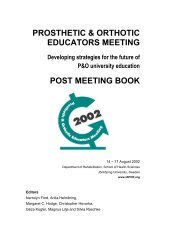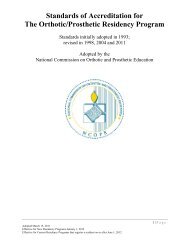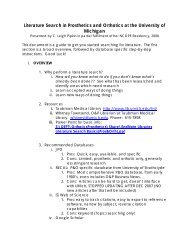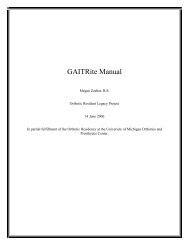Scope of Practice - NCOPE
Scope of Practice - NCOPE
Scope of Practice - NCOPE
Create successful ePaper yourself
Turn your PDF publications into a flip-book with our unique Google optimized e-Paper software.
Orthotics and Prosthetics<br />
<strong>Scope</strong> <strong>of</strong> <strong>Practice</strong><br />
American Board for Certification in Orthotics and Prosthetics, Inc.
SCOPE OF PRACTICE TASK FORCE<br />
Rick G. Parr, CPO, FAAOP, Chairman<br />
William J. Barringer, CO, FAAOP<br />
Michael D. Brncick, CPO<br />
Donald Deane Doty, Jr., CPO<br />
Deborah V. Graham, CPO<br />
John H. Reynolds, CPO, FAAOP<br />
Steven R. Whiteside, CO, FAAOP<br />
Catherine A. Carter<br />
Robin C. Seabrook<br />
American Board for Certification in Orthotics and Prosthetics, Inc.<br />
330 John Carlyle Street, Suite 210<br />
Alexandria, VA 22314<br />
703-836-7114<br />
www.abcop.org<br />
©2003 by the American Board for Certification in Orthotics and Prosthetics, Inc.<br />
All rights reserved. No part <strong>of</strong> this document may be produced in any form without written<br />
permission <strong>of</strong> the American Board for Certification in Orthotics and Prosthetics, Inc.
FOREWORD<br />
The Board <strong>of</strong> Directors <strong>of</strong> the American Board for Certification in Orthotics and<br />
Prosthetics, Inc., (ABC) commissioned a task force to develop an Orthotic and Prosthetic<br />
<strong>Scope</strong> <strong>of</strong> <strong>Practice</strong> document for use by orthotic and prosthetic pr<strong>of</strong>essionals, consumers,<br />
members <strong>of</strong> the rehabilitation team and health care decision makers. To write this<br />
consensus document, the task force used a variety <strong>of</strong> resources including the 1996 Report<br />
<strong>of</strong> the Task Force on the <strong>Scope</strong> <strong>of</strong> <strong>Practice</strong> in Orthotics and Prosthetics and the <strong>Practice</strong><br />
Analysis <strong>of</strong> the Disciplines <strong>of</strong> Orthotics and Prosthetics. In addition, the task force conducted<br />
both a survey <strong>of</strong> the pr<strong>of</strong>ession as well as interviews with credentialed individuals.<br />
This Orthotic and Prosthetic <strong>Scope</strong> <strong>of</strong> <strong>Practice</strong> document defines several aspects <strong>of</strong> the<br />
orthotic and prosthetic pr<strong>of</strong>essions, including the scope <strong>of</strong> comprehensive orthotic and<br />
prosthetic care, the specific tasks performed by orthotic and prosthetic pr<strong>of</strong>essionals and<br />
the common terms used in the pr<strong>of</strong>ession. This document also delineates the levels <strong>of</strong><br />
orthotic and prosthetic supervision and identifies where orthotists and prosthetists work<br />
as well as what devices they provide.<br />
Any scope <strong>of</strong> practice document should be revised periodically, and it is the intent <strong>of</strong> ABC<br />
to revise this document as the practice <strong>of</strong> orthotics and prosthetics changes.<br />
This publication represents the shared efforts <strong>of</strong> many dedicated individuals. ABC is<br />
grateful for the commitment <strong>of</strong> the task force members and staff who devoted their time<br />
and effort to this project.<br />
Jack E. Uellendahl, CPO<br />
President
INTRODUCTION<br />
Orthotics and prosthetics is a specialized health care pr<strong>of</strong>ession, which combines a unique<br />
blend <strong>of</strong> clinical and technical skills. Orthotists and prosthetists evaluate patients and<br />
custom design, fabricate and fit orthoses and prostheses. Orthotic patients have<br />
neuromuscular and musculoskeletal disorders, and prosthetic patients have a partial or<br />
total absence <strong>of</strong> a limb. Orthotists and prosthetists give their patients the ability to lead<br />
more active and independent lives by working with other members <strong>of</strong> the rehabilitation<br />
team to create a treatment plan and custom device. This work requires substantial clinical<br />
and technical judgment.<br />
The practice <strong>of</strong> orthotics and prosthetics has its history in the artisans and other skilled<br />
craftsmen <strong>of</strong> the past. Many <strong>of</strong> the developments <strong>of</strong> the 20th century in both pr<strong>of</strong>essions<br />
came out <strong>of</strong> the world wars and the polio epidemics <strong>of</strong> the 1950s. Today’s practitioners<br />
work in a variety <strong>of</strong> settings and use innovative materials and techniques to restore<br />
function and provide relief for many impairments.<br />
The principles <strong>of</strong> biomechanics, pathomechanics, gait analysis, kinesiology, anatomy and<br />
physiology are crucial to the practitioner’s ability to provide comprehensive patient care<br />
and a positive clinical outcome. Patient assessment, treatment and education are part <strong>of</strong><br />
the practitioner’s responsibility and require collaborative communication skills.<br />
The pr<strong>of</strong>essions <strong>of</strong> orthotics and prosthetics have advanced together, as the same skills and<br />
knowledge base are necessary to evaluate for and design custom orthoses and prostheses.<br />
The scope <strong>of</strong> orthotic and prosthetic practice is delineated in this publication to assist<br />
those with an interest in the pr<strong>of</strong>essions or with a need to describe the pr<strong>of</strong>essions to other<br />
interested parties.<br />
EDUCATION AND EXPERIENCE QUALIFICATIONS<br />
Individuals interested in an education in orthotics and prosthetics attend schools with<br />
curriculum specific programs accredited by the Commission on Accreditation <strong>of</strong> Allied<br />
Health Education Programs (CAAHEP) and the National Commission on Orthotic and<br />
Prosthetic Education (<strong>NCOPE</strong>). The accredited educational programs meet standards <strong>of</strong><br />
quality designed to prepare individuals to enter the orthotic and prosthetic pr<strong>of</strong>essions at<br />
all levels.<br />
Orthotic and prosthetic assistants and technicians may attend associate degree or<br />
certificate level programs that include hands-on experience and emphasize the technical<br />
1<br />
<strong>Scope</strong> <strong>of</strong> Orthotic and Prosthetic <strong>Practice</strong>
and assistive aspects <strong>of</strong> the pr<strong>of</strong>ession. Assistants, technicians and fitters also enter the<br />
field through on-the-job training.<br />
Orthotic and prosthetic practitioners receive their baccalaureate or post-baccalaureate<br />
education at colleges or universities. Post-baccalaureate clinical experience is required<br />
through a structured residency program. <strong>NCOPE</strong> accredited residency sites provide the<br />
orthotic and prosthetic resident with qualified experience that extends the education and<br />
training process into the patient management setting.<br />
CREDENTIALING<br />
Orthotic and prosthetic board certification and registration are available to members <strong>of</strong><br />
the pr<strong>of</strong>ession through the American Board for Certification in Orthotics and Prosthetics,<br />
Inc., (ABC). Established in 1948, ABC’s credentialing program seeks to recognize those<br />
who have met specific educational and residency standards and who have demonstrated a<br />
level <strong>of</strong> knowledge and clinical skills through successfully completing the certification or<br />
registration examinations.<br />
ABC credentialed individuals must obtain mandatory continuing education credits to<br />
maintain their certification/registration at a five-year renewal cycle. They are also bound<br />
by a code <strong>of</strong> ethical conduct that provides a framework for pr<strong>of</strong>essional conduct in<br />
consideration <strong>of</strong> the patient, allied health colleagues and the pr<strong>of</strong>ession.<br />
ABC credentialing requirements were established to maintain improved quality <strong>of</strong> care,<br />
assure patient safety and promote the appropriate utilization <strong>of</strong> orthotic and prosthetic<br />
services.<br />
The following credentials are awarded by ABC:<br />
CO, Certified Orthotist<br />
CP, Certified Prosthetist<br />
CPO, Certified Prosthetist-Orthotist<br />
ROA, Registered Orthotic Assistant<br />
RPA, Registered Prosthetic Assistant<br />
RPOA, Registered Prosthetic-Orthotic Assistant<br />
RTO, Registered Orthotic Technician<br />
RTP, Registered Prosthetic Technician<br />
RTPO, Registered Prosthetic-Orthotic Technician<br />
RFO, Registered Fitter-Orthotics<br />
RFM, Registered Fitter-Mastectomy<br />
RFOM, Registered Fitter-Orthotics/Mastectomy<br />
2<br />
<strong>Scope</strong> <strong>of</strong> Orthotic and Prosthetic <strong>Practice</strong>
PRACTICE SETTINGS<br />
The practice <strong>of</strong> orthotics and prosthetics is carried out in many settings, including the<br />
following:<br />
☛<br />
☛<br />
☛<br />
☛<br />
☛<br />
☛<br />
☛<br />
☛<br />
☛<br />
Orthotic and prosthetic facilities<br />
Hospitals<br />
Specialty clinics<br />
Acute care facilities<br />
Rehabilitation facilities<br />
University and research facilities<br />
Rural outreach clinics<br />
Home health settings<br />
Skilled nursing facilities<br />
AREAS OF RESPONSIBILITY PERFORMED BY ABC<br />
CREDENTIALED ORTHOTIC AND PROSTHETIC PROFESSIONALS<br />
Patient Assessment<br />
Perform a comprehensive assessment <strong>of</strong> the patient to obtain an understanding <strong>of</strong> the<br />
patient’s orthotic/prosthetic needs:<br />
☛ Review patient’s prescription/referral.<br />
☛ Take a comprehensive patient history, including demographic characteristics, family<br />
dynamics, previous use <strong>of</strong> an orthosis/prosthesis, diagnosis, work history, avocational<br />
activities, signs and symptoms, medical history (including allergies to materials),<br />
reimbursement status, patient expectations, results <strong>of</strong> diagnostic evaluations.<br />
☛ Assist in formulating the treatment plan by performing a diagnosis-specific functional<br />
clinical examination, including manual muscle testing, gait assessment and evaluation<br />
<strong>of</strong> sensory function, cognitive ability, range <strong>of</strong> motion, joint stability, skin integrity<br />
and compliance.<br />
☛ Consult with other health care pr<strong>of</strong>essionals and caregivers about patient’s condition<br />
to assist in formulating a treatment plan.<br />
☛ Communicate with patient and/or caregiver about the recommended treatment plan,<br />
and any optional plans, to involve them in orthotic or prosthetic care; include<br />
disclosure <strong>of</strong> potential risks/benefits.<br />
3<br />
<strong>Scope</strong> <strong>of</strong> Orthotic and Prosthetic <strong>Practice</strong>
☛ Verify patient care by documenting history, ongoing care and follow-up, using<br />
established record-keeping techniques.<br />
☛ Refer patient, if appropriate, to other health care pr<strong>of</strong>essionals (e.g., psychologist,<br />
therapist, physician) for intervention beyond orthotic/prosthetic scope <strong>of</strong> practice.<br />
Formulation <strong>of</strong> the Treatment Plan<br />
Create a comprehensive orthotic/prosthetic treatment plan to meet the needs and goals <strong>of</strong><br />
the patient:<br />
☛ Evaluate the findings to determine an orthotic/prosthetic recommendation.<br />
☛ Formulate treatment goals and expected orthotic/prosthetic outcomes to reduce<br />
pain/increase comfort, enhance function and independence, provide stability, prevent<br />
deformity, address cosmesis and/or promote healing.<br />
☛ Consult with physician/referral source to modify, if necessary, the original prescription<br />
and/or treatment plan.<br />
☛ Identify material, design and components to support anticipated outcome.<br />
☛ Develop a plan for patient needs, including patient education and follow-up.<br />
☛ Document treatment plan using established record-keeping techniques to verify<br />
patient care.<br />
☛ Inform patient or responsible parties <strong>of</strong> their financial responsibilities, pertaining to<br />
proposed treatment plan.<br />
Implementation <strong>of</strong> the Treatment Plan<br />
Perform the necessary procedures to deliver the appropriate orthotic/prosthetic services,<br />
which may include fabrication <strong>of</strong> the orthosis/prosthesis:<br />
☛ Inform patient, family and/or caregiver <strong>of</strong> the orthotic/prosthetic procedure, possible<br />
risks and time involved in the procedure.<br />
☛ Select appropriate material/techniques to implement treatment plan.<br />
4<br />
<strong>Scope</strong> <strong>of</strong> Orthotic and Prosthetic <strong>Practice</strong>
☛ Provide patient with preparatory care for orthotic/prosthetic treatment (e.g.,<br />
diagnostic splint, residual limb shrinker).<br />
☛ Prepare patient for procedure required to initiate treatment plan (e.g., take<br />
impression, digitize, delineate, scan).<br />
☛ Implement procedure (e.g., take impression, digitize, delineate, scan).<br />
☛ Select appropriate materials, components and specifications for orthosis/prosthesis<br />
based on patient criteria to ensure optimum strength, durability and function as<br />
required (e.g., choose ankle or knee joints, feet, knee units; choose material <strong>of</strong><br />
components, lamination layups).<br />
☛ Consult technical component/material resources as required.<br />
☛ Prepare delineation/impression/template for modification/fabrication (e.g., prepare<br />
impression/reverse delineation, seal and fill impression/pour cast, digitize, strip<br />
model, download shape to carver or modification s<strong>of</strong>tware).<br />
☛ Modify and prepare patient model for fabrication.<br />
☛ Fabricate/assemble prescribed device by assembling selected materials/components to<br />
prepare for fitting and/or delivery (e.g., laminate/vacuum-form, remove<br />
socket/orthosis from model, smooth and finish orthosis/prosthesis, contour side bars<br />
to model/delineation, smooth and finish side bars, bench align components to socket,<br />
strap orthosis/prosthesis as necessary, perform final assembly <strong>of</strong> orthosis/prosthesis<br />
for patient fitting/delivery).<br />
☛ Assess device for structural safety and ensure that manufacturers' guidelines have been<br />
followed prior to patient fitting/delivery (e.g., torque values, patient weight limits).<br />
☛ Assess/align orthosis/prosthesis for accuracy in sagittal, transverse and coronal planes<br />
to provide maximum function/comfort.<br />
☛ Provide gait training/functional-use training.<br />
☛ Ensure that materials, design and components are fit/delivered as prescribed.<br />
☛ Complete fabrication process after achieving optimal fit <strong>of</strong> orthosis/prosthesis (e.g.,<br />
convert test socket to definitive orthosis/prosthesis).<br />
<strong>Scope</strong> <strong>of</strong> Orthotic and Prosthetic <strong>Practice</strong><br />
5
☛ Educate/counsel patient and/or caregiver about the use and maintenance <strong>of</strong> the<br />
orthosis/prosthesis (e.g., wear schedules, therapy, other instructions).<br />
☛ Reassess orthosis/prosthesis for structural safety prior to patient delivery (e.g., screws<br />
tightened, cover attached).<br />
☛ Document treatment using established record-keeping techniques to verify<br />
implementation <strong>of</strong> treatment plan.<br />
Follow-up Treatment Plan<br />
Provide continuing patient care and periodic evaluation to assure/maintain/document<br />
optimal fit and function <strong>of</strong> the orthosis/prosthesis:<br />
☛ Solicit subjective feedback from patient and/or caregiver to determine status (e.g.,<br />
wear schedule/tolerance, comfort, perceived benefits, perceived detriments, ability to<br />
don and d<strong>of</strong>f, proper usage and function, overall patient satisfaction).<br />
☛ Assess patient’s functional level.<br />
☛ Assess patient’s skin condition (e.g., integrity, color, temperature, volume).<br />
☛ Assess patient’s general health, height, and weight, and note any changes.<br />
☛ Assess patient’s psychosocial status, and note any changes (e.g., family status, job,<br />
caregiver).<br />
☛ Assess fit <strong>of</strong> orthosis/prosthesis with regard to strategic contact (e.g., three-point force<br />
systems, total contact) to determine need for changes relative to initial treatment goals.<br />
☛<br />
Assess fit <strong>of</strong> orthosis/prosthesis with regard to anatomical relationships to<br />
orthosis/prosthesis (e.g., trimlines, static/dynamic alignment) to determine need for<br />
changes relative to initial treatment goals.<br />
☛ Formulate plan to modify orthosis/prosthesis based on findings; inform patient<br />
and/or caregiver <strong>of</strong> plan to modify orthosis/prosthesis.<br />
☛ Make or delegate modifications to orthosis/prosthesis (e.g., relieve pressure, change<br />
range <strong>of</strong> motion, change alignment, change components, add pressure-sensitive pad).<br />
6<br />
<strong>Scope</strong> <strong>of</strong> Orthotic and Prosthetic <strong>Practice</strong>
☛ Assess modified device for structural safety, and ensure that manufacturers' guidelines<br />
(e.g., torque values, patient weight limits) have been followed.<br />
☛ Evaluate modifications to orthosis/prosthesis, including static and dynamic assessment<br />
to confirm that goals and objectives <strong>of</strong> modifications have been met.<br />
☛ Reassess patient knowledge and understanding <strong>of</strong> goals and objectives to ensure<br />
proper use <strong>of</strong> orthosis/prosthesis relative to modifications.<br />
☛ Document all findings and actions and communicate with appropriate health care<br />
pr<strong>of</strong>essionals (e.g., referral sources, colleagues, supervisor) to ensure patient status is<br />
updated.<br />
<strong>Practice</strong> Management<br />
Develop, implement and/or monitor policies and procedures regarding human resource<br />
management, physical environment management, business/financial management and<br />
organizational management:<br />
☛ Plan, implement, evaluate and document policies and procedures in compliance with<br />
all applicable federal and state laws and regulations as well as pr<strong>of</strong>essional and ethical<br />
guidelines (e.g., FDA, ADA, OSHA, MSDS, ABC Canon <strong>of</strong> Ethics).<br />
☛ Develop and implement personnel policies and procedures (e.g., benefits, training,<br />
incentives, staff recognition, regular performance appraisals).<br />
☛<br />
Establish procedures for patient care that comply with accepted medical/legal<br />
requirements, and maintain current education in those areas.<br />
☛ Demonstrate proper documentation <strong>of</strong> patient history and financial records by using<br />
established record-keeping techniques to verify patient care and other pertinent<br />
information.<br />
☛ Communicate roles and expectations <strong>of</strong> employer and employees by providing<br />
documentation to create a pr<strong>of</strong>essional, cooperative working environment and<br />
improve patient care.<br />
7<br />
<strong>Scope</strong> <strong>of</strong> Orthotic and Prosthetic <strong>Practice</strong>
Promotion <strong>of</strong> Competency and Enhancement <strong>of</strong> Pr<strong>of</strong>essional <strong>Practice</strong><br />
Participate in personal and pr<strong>of</strong>essional development through continuing education,<br />
training, research and organizational affiliations:<br />
☛ Participate in continuing education and/or provide such education for other health<br />
care pr<strong>of</strong>essionals, orthotic and prosthetic practitioners, assistants, technicians, fitters<br />
and <strong>of</strong>fice staff (e.g., publications, seminars, case studies).<br />
☛ Participate in education for residents, students and trainees.<br />
☛ Conduct or participate in product development research, clinical trials and outcome<br />
evaluation studies.<br />
☛ Participate in the development, implementation and monitoring <strong>of</strong> public policy<br />
regarding orthotics/prosthetics (e.g., provide testimony/information to legislative/<br />
regulatory bodies, serve on pr<strong>of</strong>essional committees and regulatory agencies).<br />
☛ Participate in/with consumer organizations and nongovernmental organizations to<br />
promote competency and enhancement <strong>of</strong> orthotic/prosthetic pr<strong>of</strong>ession.<br />
COMMONLY USED ORTHOSES<br />
Foot orthosis (FO)<br />
Ankle-foot orthosis (AFO)<br />
Knee orthosis (KO)<br />
Knee-ankle-foot orthosis (KAFO)<br />
Fracture orthosis<br />
Hip orthosis (HO)<br />
Hip-knee-ankle-foot orthosis (HKAFO)<br />
Lumbosacral orthosis (LSO)<br />
Thoracolumbosacral orthosis (TLSO)<br />
Thoracolumbar orthosis (TLO)<br />
Cervicothoracolumbosacral orthosis (CTLSO)<br />
Cervical orthosis (CO)<br />
Cranial remolding orthosis (CRO)<br />
Cervicothoracic orthosis (CTO)<br />
Halo cervical orthosis<br />
Hand orthosis (HdO)<br />
Wrist-hand orthosis (WHO)<br />
Wrist orthosis (WO)<br />
Elbow orthosis (EO)<br />
Elbow-wrist-hand orthosis (EWHO)<br />
Shoulder-elbow-wrist-hand orthosis<br />
(SEWHO)<br />
Shoulder orthosis (SO)<br />
Custom shoes<br />
Diabetic footwear<br />
Gradient compression hose<br />
Custom seating<br />
<strong>Scope</strong> <strong>of</strong> Orthotic and Prosthetic <strong>Practice</strong><br />
8
COMMONLY USED PROSTHESES<br />
Postoperative prosthesis<br />
Partial foot prosthesis<br />
Symes prosthesis<br />
Transtibial prosthesis<br />
Knee disarticulation prosthesis<br />
Transfemoral prosthesis<br />
Hip disarticulation prosthesis<br />
Hemi-pelvectomy prosthesis<br />
Partial hand prosthesis<br />
Wrist disarticulation prosthesis<br />
Transradial prosthesis<br />
Elbow disarticulation prosthesis<br />
Transhumeral prosthesis<br />
Shoulder disarticulation prosthesis<br />
Cosmetic restoration prosthesis<br />
Mastectomy prosthesis<br />
Myoelectric prosthesis<br />
Microprocessor prosthesis<br />
Programmable function prosthesis<br />
ORTHOTIC AND PROSTHETIC PATIENT CARE AND SERVICE<br />
PROVIDERS<br />
ABC Certified Orthotist and/or Prosthetist<br />
An ABC certified orthotist or prosthetist is an allied health pr<strong>of</strong>essional who is specifically<br />
trained and educated to manage the provision <strong>of</strong> comprehensive orthotic and prosthetic<br />
care, based upon a clinical assessment and a physician’s prescription, to restore<br />
physiological function and/or cosmesis.<br />
The ABC certified practitioner independently provides or supervises the provision <strong>of</strong><br />
comprehensive orthotic and prosthetic care. This includes patient assessment,<br />
formulation <strong>of</strong> a treatment plan, implementation <strong>of</strong> the treatment plan, follow-up and<br />
practice management.<br />
The practitioner certified by the American Board for Certification in Orthotics and<br />
Prosthetics, Inc., (ABC) is bound by the ABC Canons <strong>of</strong> Ethical Conduct, which are<br />
enforced by a Pr<strong>of</strong>essional Discipline program. The certified practitioner is obligated to<br />
support and conform to pr<strong>of</strong>essional responsibilities that promote and assure the overall<br />
welfare <strong>of</strong> the patient and the integrity <strong>of</strong> the pr<strong>of</strong>ession. The time-limited certification is<br />
based on participation in the Mandatory Continuing Education program.<br />
9<br />
<strong>Scope</strong> <strong>of</strong> Orthotic and Prosthetic <strong>Practice</strong>
ABC Registered Assistant<br />
An ABC registered assistant is an individual trained and qualified to participate in the<br />
delivery <strong>of</strong> orthotic and prosthetic care while under the clinical supervision <strong>of</strong> an ABC<br />
certified practitioner.<br />
The registered assistant supports the ABC certified practitioner by assisting in orthotic<br />
and prosthetic patient care. Under the guidance and supervision <strong>of</strong> the ABC certified<br />
practitioner, registered assistants may perform orthotic and prosthetic procedures and<br />
related tasks in the management <strong>of</strong> patients. The registered assistant also fabricates,<br />
repairs and maintains devices to provide maximum fit, function and cosmesis.<br />
ABC registered assistants may not use their credentials as independent practitioners<br />
engaged in unsupervised patient care. The registered assistant is bound by the ABC<br />
Canons <strong>of</strong> Ethical Conduct, which are enforced by a Pr<strong>of</strong>essional Discipline program. The<br />
registered assistant is obligated to support and conform to pr<strong>of</strong>essional responsibilities<br />
that promote and assure the overall welfare <strong>of</strong> the patient and the integrity <strong>of</strong> the<br />
pr<strong>of</strong>ession. The time-limited registration is based on participation in the Mandatory<br />
Continuing Education program.<br />
ABC Registered Technician<br />
An ABC registered technician is an individual who supports the ABC certified practitioner<br />
by providing the technical implementation tasks and services associated with the support<br />
<strong>of</strong> patient care. Under the supervision <strong>of</strong> and in consultation with the practitioner, the<br />
registered technician fabricates, repairs and maintains devices to provide maximum fit,<br />
function and cosmesis. The registered technician is expected to keep abreast <strong>of</strong> all new<br />
fabricating techniques, must be familiar with the properties <strong>of</strong> pertinent materials and<br />
must be skilled in the use <strong>of</strong> appropriate equipment.<br />
ABC registered technicians may not use their credentials as independent practitioners<br />
engaged in direct patient care. The registered technician is bound by the ABC Canons <strong>of</strong><br />
Ethical Conduct, which are enforced by a Pr<strong>of</strong>essional Discipline program. The registered<br />
technician is obligated to support and conform to pr<strong>of</strong>essional responsibilities that<br />
promote and assure the overall welfare <strong>of</strong> the patient and the integrity <strong>of</strong> the pr<strong>of</strong>ession.<br />
The time-limited registration is based on participation in the Mandatory Continuing<br />
Education program.<br />
ABC Registered Fitter-Orthotics<br />
An ABC registered fitter-orthotics is an individual trained and qualified to participate in<br />
the fitting and delivery <strong>of</strong> prefabricated orthotic devices and/or s<strong>of</strong>t goods. An ABC<br />
registered fitter-orthotics is competent to practice orthotics within a scope <strong>of</strong> practice that<br />
is specific to fitting prefabricated and <strong>of</strong>f-the-shelf orthoses as described below:<br />
10<br />
<strong>Scope</strong> <strong>of</strong> Orthotic and Prosthetic <strong>Practice</strong>
• Cervical orthoses not requiring more than minor modification<br />
• Pressure gradient hose<br />
• Trusses<br />
• Prefabricated spinal orthoses, except those used in the treatment <strong>of</strong> scoliosis, rigid<br />
body jackets made <strong>of</strong> therm<strong>of</strong>ormable materials, and halo devices<br />
• Prefabricated orthoses <strong>of</strong> upper and lower extremities, except those used in the<br />
treatment <strong>of</strong> bone fractures<br />
The registered fitter-orthotics is bound by the ABC Canons <strong>of</strong> Ethical Conduct, which are<br />
enforced by a Pr<strong>of</strong>essional Discipline program. The registered fitter-orthotics is obligated<br />
to support and conform to pr<strong>of</strong>essional responsibilities that promote and assure the<br />
overall welfare <strong>of</strong> the patient and the integrity <strong>of</strong> the pr<strong>of</strong>ession. The time-limited<br />
registration is based on participation in the Mandatory Continuing Education program.<br />
ABC Registered Fitter-Mastectomy<br />
An ABC registered fitter-mastectomy is an individual trained and qualified to participate<br />
in the fitting and delivery <strong>of</strong> breast prostheses and mastectomy products and services. An<br />
ABC registered fitter-mastectomy is competent to practice within a scope <strong>of</strong> practice that<br />
is specific to fitting breast prostheses and mastectomy products and services.<br />
The registered fitter-mastectomy is bound by the ABC Canons <strong>of</strong> Ethical Conduct, which<br />
are enforced by a Pr<strong>of</strong>essional Discipline program. The registered fitter-mastectomy is<br />
obligated to support and conform to pr<strong>of</strong>essional responsibilities that promote and<br />
assure the overall welfare <strong>of</strong> the patient and the integrity <strong>of</strong> the pr<strong>of</strong>ession. The timelimited<br />
registration is based on participation in the Mandatory Continuing Education<br />
program.<br />
Other Personnel<br />
Other personnel who work within the orthotic and prosthetic facility and under the<br />
supervision <strong>of</strong> an ABC certified practitioner should be employed under the appropriate<br />
title such as aide, <strong>of</strong>fice support personnel, etc. Any involvement with the provision <strong>of</strong><br />
patient care must be within the scope <strong>of</strong> the individual’s education and experience and<br />
must be directly supervised by the ABC certified practitioner.<br />
LEVELS OF SUPERVISION OF ORTHOTIC AND PROSTHETIC<br />
PATIENT CARE<br />
Direct Supervision<br />
The caregiver is qualified to provide patient care under the direct on-site supervision <strong>of</strong><br />
an ABC certified practitioner. The supervisor must be available for consultation<br />
11<br />
<strong>Scope</strong> <strong>of</strong> Orthotic and Prosthetic <strong>Practice</strong>
throughout the patient care process, must review the results <strong>of</strong> care rendered by the<br />
supervised individual and is responsible for countersigning within 15 days all entries by<br />
the caregiver in the patient’s clinical record.<br />
Indirect Supervision<br />
The caregiver is qualified to provide patient care as delegated by the ABC certified<br />
practitioner. The supervisor is not required to be on-site but must be available for<br />
immediate consultation during the delivery <strong>of</strong> care. The supervisor must review and<br />
countersign within 15 days all entries in the patient’s clinical record.<br />
The levels <strong>of</strong> supervision required per practice domain are summarized below:<br />
Domain<br />
Patient Assessment<br />
Registered<br />
Assistant<br />
Direct<br />
Registered<br />
Technician<br />
N/A<br />
Other<br />
Personnel*<br />
N/A<br />
Formulation <strong>of</strong> the Treatment Plan<br />
Direct<br />
N/A<br />
N/A<br />
Implementation <strong>of</strong> the Treatment Plan<br />
Indirect<br />
Direct<br />
Direct<br />
Follow-up Treatment Plan<br />
Indirect<br />
Direct<br />
Direct<br />
<strong>Practice</strong> Management<br />
N/A<br />
N/A<br />
Direct<br />
Promotion <strong>of</strong> Competency and<br />
Enhancement <strong>of</strong> Pr<strong>of</strong>essional <strong>Practice</strong><br />
Indirect<br />
Direct<br />
Direct<br />
*The registered fitter working for an ABC accredited facility is indirectly supervised. All registered fitters must<br />
provide patient care services strictly within their limited scope <strong>of</strong> practice.<br />
THE FUTURE OF ORTHOTICS AND PROSTHETICS<br />
The number <strong>of</strong> people requiring orthotic and prosthetic care is expected to increase as the<br />
proportion <strong>of</strong> the population in the age groups at highest risk for orthotic and prosthetic<br />
care increases. In conjunction with an increased demand for orthotic and prosthetic<br />
pr<strong>of</strong>essionals, there are certain areas <strong>of</strong> orthotic and prosthetic expertise that will need to<br />
be expanded. Developments such as computer-aided design, osteointegration and<br />
electronically powered and computer-controlled components for hands, elbows and knees<br />
are challenging orthotists and prosthetists to expand their knowledge base.<br />
There continues to be an expansion in the materials and complex designs available for<br />
orthotic and prosthetic use. This also requires that orthotists and prosthetists have a better<br />
understanding <strong>of</strong> material science so that these materials can be used in the most effective<br />
manner. The practice <strong>of</strong> orthotics and prosthetics is increasingly more clinically based.<br />
This requires better analytical problem-solving skills, keener interpersonal<br />
communication skills, greater knowledge <strong>of</strong> computers and a larger emphasis on<br />
outcomes <strong>of</strong> patient care.<br />
12<br />
<strong>Scope</strong> <strong>of</strong> Orthotic and Prosthetic <strong>Practice</strong>
GLOSSARY<br />
ABC<br />
The American Board for Certification in Orthotics and Prosthetics, Inc., (ABC) establishes<br />
and promotes the highest standards <strong>of</strong> organizational and clinical performance in the delivery<br />
<strong>of</strong> orthotic and prosthetic care. ABC advances the competency <strong>of</strong> practitioners, promotes the<br />
quality and effectiveness <strong>of</strong> orthotic and prosthetic care and maintains the integrity <strong>of</strong> the<br />
pr<strong>of</strong>ession.<br />
CAAHEP<br />
The Commission on Accreditation <strong>of</strong> Allied Health Education Programs (CAAHEP) is a<br />
nationally recognized nonpr<strong>of</strong>it organization that accredits educational programs in allied<br />
health disciplines.<br />
CAD/CAM<br />
Computer-aided design/computer-aided manufacture.<br />
Custom Fabricated Device<br />
An orthosis or prosthesis fabricated to comprehensive measurements and/or a mold or<br />
patient model for use by a patient in accordance with a prescription and which requires<br />
clinical and technical judgment in its design, fabrication and fitting.<br />
Custom Fitted Device<br />
A prefabricated orthosis or prosthesis made to patient measurements sized or modified for<br />
use by the patient in accordance with a prescription and which requires clinical and technical<br />
judgment and substantive alteration in its design.<br />
Mandatory Continuing Education<br />
ABC credentialed individuals are required to maintain competency through mandatory<br />
continuing education by earning pr<strong>of</strong>essional continuing education credits.<br />
<strong>NCOPE</strong><br />
The National Commission on Orthotic and Prosthetic Education (<strong>NCOPE</strong>) is the<br />
accreditation body for the orthotics and prosthetics pr<strong>of</strong>ession and works in cooperation with<br />
CAAHEP. <strong>NCOPE</strong>'s primary mission is to ensure education and residency programs meet<br />
the minimum standards <strong>of</strong> quality to prepare individuals to enter the orthotics and<br />
prosthetics pr<strong>of</strong>ession.<br />
Off-the-shelf Device<br />
A prefabricated orthosis or prosthesis sized and/or modified for interim, evaluative or short<br />
term use by the patient in accordance with a prescription and which does not require clinical<br />
judgment and substantive alteration for appropriate use.<br />
13<br />
<strong>Scope</strong> <strong>of</strong> Orthotic and Prosthetic <strong>Practice</strong>
Orthotist<br />
An allied health pr<strong>of</strong>essional who is specifically trained and educated to provide or manage<br />
the provision <strong>of</strong> a custom designed, fabricated, modified and/or fitted external orthosis to an<br />
orthotic patient, based upon a clinical assessment and a physician’s prescription, to restore<br />
physiological function and/or cosmesis.<br />
Orthosis<br />
A custom designed, fabricated, fitted and/or modified device to correct, support or<br />
compensate for a neuromusculoskeletal disorder or acquired condition.<br />
Prosthesis<br />
A custom designed, fabricated, fitted and/or modified device to replace an absent external<br />
limb for purposes <strong>of</strong> restoring physiological function and/or cosmesis.<br />
Prosthetist<br />
An allied health pr<strong>of</strong>essional who is specifically trained and educated to provide or manage<br />
the provision <strong>of</strong> a custom designed, fabricated, modified and/or fitted external limb<br />
prosthesis to a prosthetic patient, based upon a clinical assessment and a physician’s<br />
prescription, to restore physiological function and/or cosmesis.<br />
Residency<br />
A 12-month supervised work experience to acquire advanced clinical training in orthotics<br />
and prosthetics in a patient management setting.<br />
Supervisor<br />
The designated ABC certified orthotist or prosthetist who oversees and is responsible for the<br />
delivery <strong>of</strong> orthotic and/or prosthetic care.<br />
Supervision (Direct)<br />
The caregiver is qualified to provide patient care under the direct on-site supervision <strong>of</strong> an<br />
ABC certified practitioner. The supervisor must be available for consultation throughout the<br />
patient care process, must review the results <strong>of</strong> care rendered by the supervised individual and<br />
is responsible for countersigning within 15 days all entries by the caregiver in the patient’s<br />
clinical record.<br />
Supervision (Indirect)<br />
The caregiver is qualified to provide patient care as delegated by the ABC certified<br />
practitioner. The supervisor is not required to be on-site but must be available for immediate<br />
consultation during the delivery <strong>of</strong> care. The supervisor must review and countersign within<br />
15 days all entries in the patient’s clinical record.<br />
14<br />
<strong>Scope</strong> <strong>of</strong> Orthotic and Prosthetic <strong>Practice</strong>
ORTHOTIC AND PROSTHETIC INFORMATION RESOURCES<br />
You may contact these organizations for additional information about<br />
orthotics and prosthetics:<br />
American Board for Certification<br />
in Orthotics and Prosthetics, Inc.<br />
330 John Carlyle Street, Suite 210<br />
Alexandria, VA 22314<br />
703-836-7114<br />
www.abcop.org<br />
American Academy <strong>of</strong><br />
Orthotists and Prosthetists<br />
526 King Street, Suite 201<br />
Alexandria, VA 22314<br />
703-836-0788<br />
www.oandp.org<br />
American Orthotic<br />
and Prosthetic Association<br />
330 John Carlyle Street, Suite 200<br />
Alexandria, VA 22314<br />
571-431-0876<br />
www.aopanet.org<br />
National Commission on<br />
Orthotic and Prosthetic Education<br />
330 John Carlyle Street, Suite 200<br />
Alexandria, VA 22314<br />
703-836-7114 ext. 237<br />
www.ncope.org<br />
Orthotic and Prosthetic<br />
Assistance Fund, Inc.<br />
1666 K Street, NW, Suite 440<br />
Washington, DC 20006<br />
202-223-8878<br />
www.opfund.org<br />
Orthotic and Prosthetic Career Information<br />
www.opcareers.com<br />
15<br />
<strong>Scope</strong> <strong>of</strong> Orthotic and Prosthetic <strong>Practice</strong>
American Board for Certification in Orthotics and Prosthetics, Inc.<br />
330 John Carlyle Street, Suite 210<br />
Alexandria, VA 22314<br />
www.abcop.org







